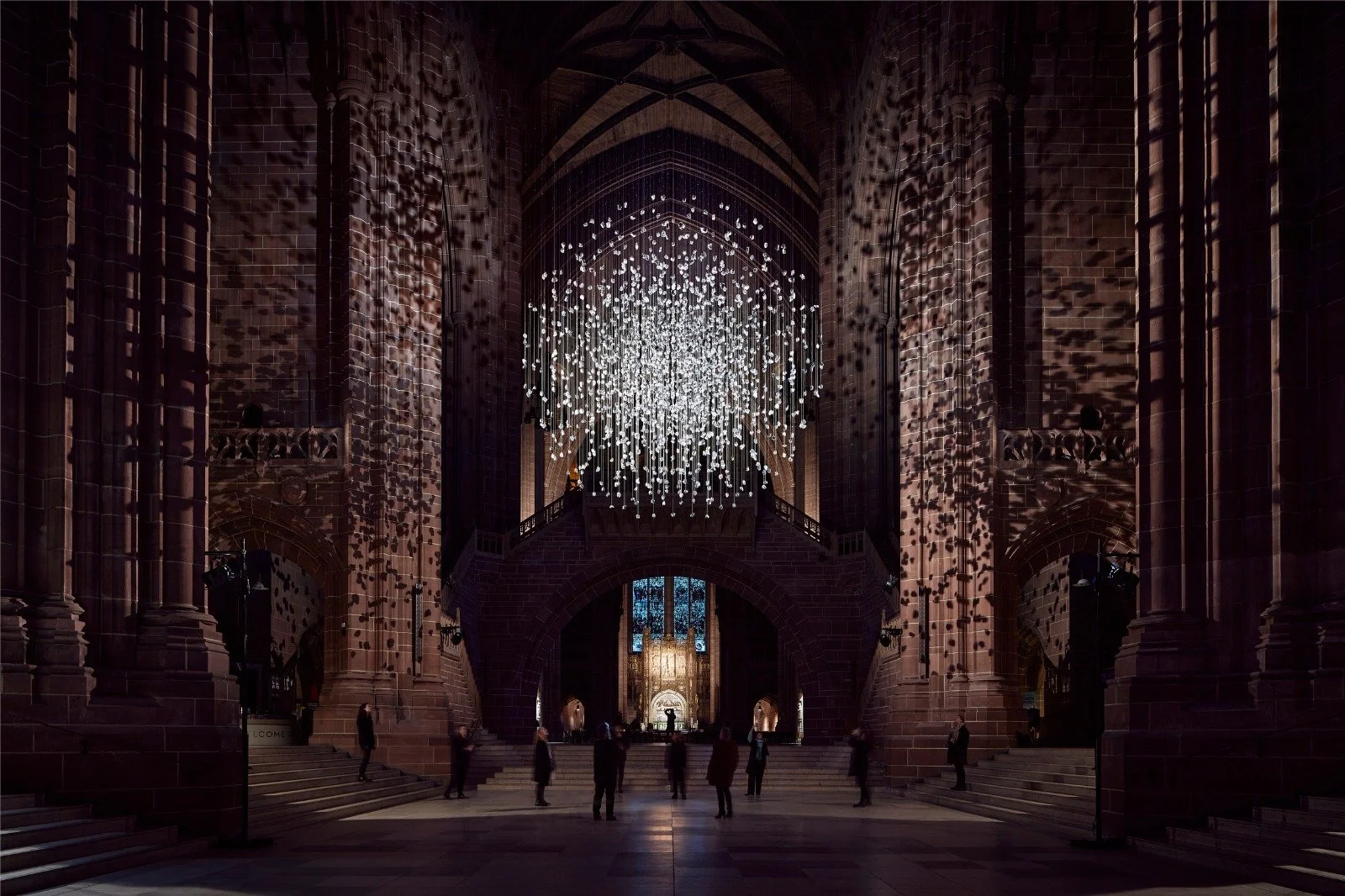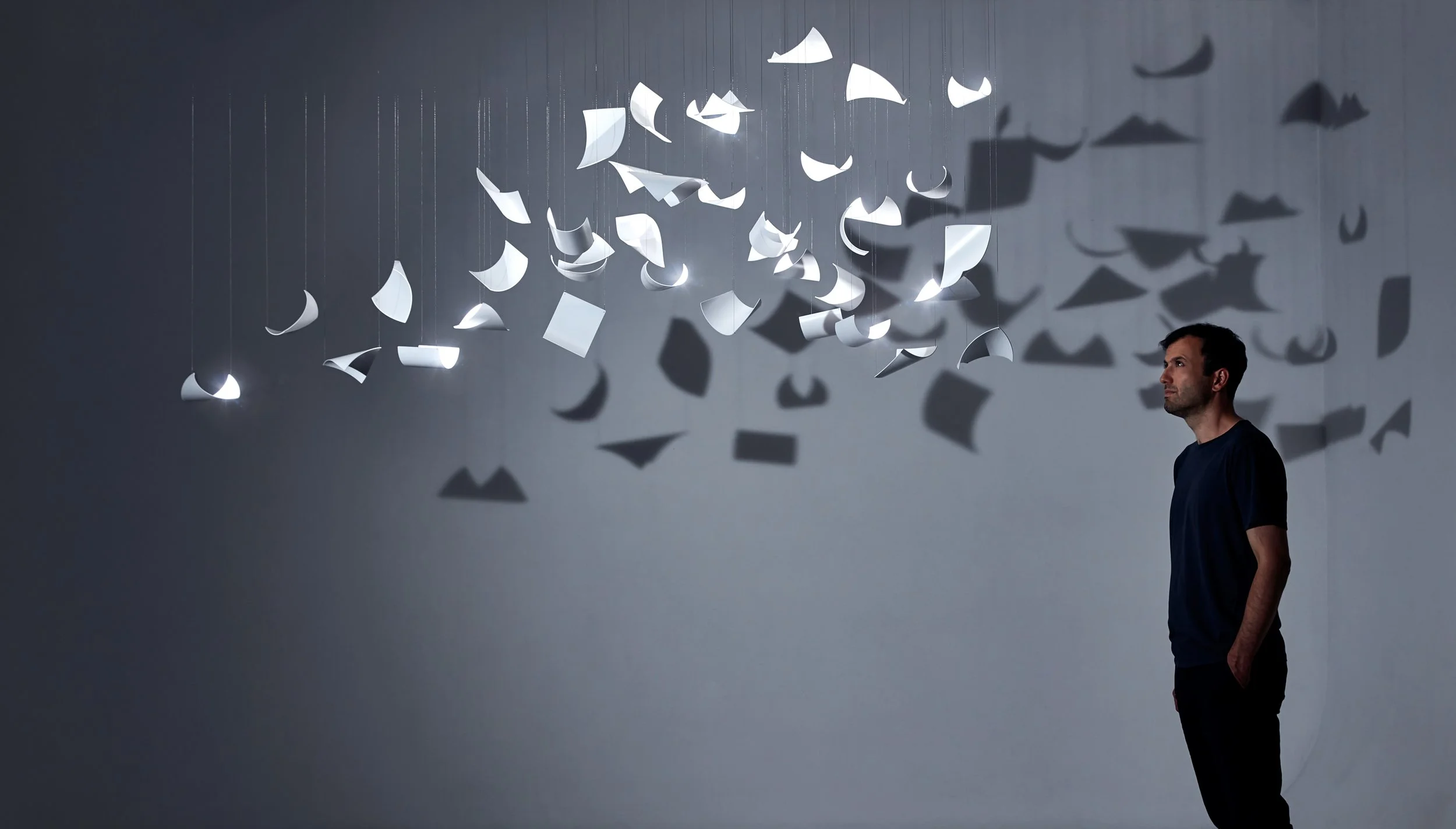In Conversation With: Paul Cocksedge
Blending art, design, and architecture, this multidisciplinary creative explores how curiosity, public engagement, and lived experience shape a practice rooted in emotion and social awareness.
Known for his poetic approach to materials and space, Paul Cocksedge blurs the boundaries between design, art, and engineering. From large-scale public installations to sculptural furniture, his work is driven by curiosity, emotion, and a desire to connect people with their environment in unexpected ways. In this exclusive interview with The Fluxx, we sit down with the London-based designer to discuss the ideas behind his latest work, the role of storytelling in design, and why simplicity can be the most powerful tool of all.
You often play with perception and scale in your work — what role does curiosity play in how you approach everyday materials or forms?
Curiosity is probably one of the most important ingredients in my creative process. I’m drawn to things I’ve never seen before — I’m constantly on the lookout to discover something new. That could come from daydreaming or from physical experimentation. Either way, I’m trying to capture that emotion of surprise and use any material or form to transmit that to the human experience.
Has there ever been a moment when a limitation — budget, space, material — led to a breakthrough you wouldn’t have otherwise reached?
Absolutely. A lot of the joy in my work comes from bringing something to life. So when I come up against budget, space, or material constraints, I don’t actually see them as limitations — I see them as creative opportunities to work around. I don’t get stopped by them. I’m addicted to the feeling of seeing the public interact with a piece — the joy it can bring. I realised early on that if I let obstacles get in the way, it would affect the overall vision and passion behind what I do, which is about realising something. The saddest moment is when a project gets paused or stopped.
Much of your work interacts with public space. How do you balance artistic expression with the social responsibility of designing for the public?
I wouldn’t use the word balance, because to me they’re one and the same. As I mentioned before, the main goal is to see the public within the work — they complete it. And yes, when you work in public space, you need to be aware of all the different rhythms that people carry with them. That’s where life experience comes in. You want things to feel good, for people to flow through or into a piece. If the work is about pausing or interaction, it should invite that gently, not force it. So in that sense, yes, there is a kind of consideration — but I don’t separate artistic intention from public responsibility.
You once said you’re drawn to ‘moments of surprise.’ How do you design something to feel spontaneous without losing intention or control?
This question feels very zoomed in — as if I’m dissecting and over-analysing my process, which I’m not. It’s always spontaneous. I’m on a journey with the work, and I don’t always know exactly where it’s going to take me. That spontaneity is baked in from the beginning. I’m not trying to design it in — I’m just open to it.
From sculptural lighting to urban installations, your work spans many disciplines. How do you know when a concept is better suited to art, design, or architecture?
Like many people have said before — including Ron Arad, who taught me at the Royal College — these disciplines constantly overlap and interact. For me, it all comes from the same place, the same creative energy. I don’t try to categorise a piece from the outset. It’s more about following where the idea naturally wants to live.
Can you tell us about a piece or project that didn’t go to plan — and what it taught you about your own process?
We once pitched for the Expo Pavilion and were shortlisted down to the final four or five. Es Devlin got it in the end. It was an intense process — the commissioners took a lot from us at that stage. We had to design nearly every detail of the pavilion and budget everything down to the last penny. What struck me was that the people making the final decision didn’t seem to value all aspects of the work we had done — or at least, that was my perception. The experience gave me a clearer insight into how competitions work: they’re complex, with many factors at play — some we could influence, others we couldn’t. I was proud of what we put forward. It was a celebration of colour, with each country at the Expo contributing — an outward-looking, collaborative concept. It felt especially relevant at the time, with the UK having just left the EU. It felt like the right energy to transmit. What I took from that experience is that you have to focus your energy on the places where projects can actually come to life. Competitions can be full of distractions and noise. That process helped sharpen my instincts about where — and how — to focus my time.
How do you stay creatively motivated in a world that increasingly values speed and productivity over experimentation?
This is a very timely question, especially with the rise of AI. What we’re seeing now isn’t just suggestion — it’s actual proof that the technology can generate images, films, even ideas and words in seconds. We’ve seen how ChatGPT has done this — it’s almost like a magic trick. There’s an undeniable excitement to it. Something that might take my studio two weeks to develop can now be done in seconds. That kind of speed is incredible. But at the same time, there’s something that feels very soulless about the whole experience. There’s an oddness to simply prompting, and that being the trigger for creation. For me, part of the thrill of creativity has always been figuring it out in one’s own mind — the intensity of wrestling with it, working through it, discovering it through process. I understand that in some contexts, certain processes benefit from this kind of acceleration. And yes, this is going to have a massive impact — not just on the creative industries, but on the job market more broadly. For me, the bigger point is that the creative world so many of us deeply value is now being disrupted by a very small number of people in tech, without any of us being consulted — and governments don’t seem to be reacting or giving us a voice in the discussion. And because creativity is often tied to money, and businesses are always looking to cut costs, this disruption will seep in quickly. A lot will be lost. That’s difficult to watch. At the same time, I also believe there’s space for those of us who operate outside that sharp commercial edge — in what I’d describe more as the broader realm of art. In those spaces, there’s still room to breathe.
Your projects often spark emotional, tactile responses. How conscious are you of designing for the senses beyond just the visual?
In my work, I’ve found that to make an emotional connection, there needs to be a level of participation — something that invites the person in. And I’ve always instinctively felt that. It’s not just about what something looks like, but how it makes you feel when you’re near it, inside it, or touching it. Studying design is important to mention here — a big part of what design teaches is how the body relates to the physical world, whether that’s the natural world or something human-made. So I think it’s a combination of those two things — instinct and education. And I’ve been doing this for so long now that it doesn’t feel like I’m trying to force that point. It’s just intuitive.
If you could collaborate with a non-designer — a poet, a chef, a neuroscientist — who would it be and why?
I think I’d love to collaborate with a politician, or with politics more broadly, because I believe that good policy ideas have the potential to create meaningful, positive change in society. I love cities, and I love London for all sorts of reasons. It’s full of energy, business, creativity, and beautiful open spaces. But during the same walk to work each day, I also see moments where the city clearly isn’t working. To me, the combination of creative thinking and well-informed policy is incredibly powerful. Design on its own can only go so far. When it’s paired with political will and a real understanding of people’s needs, that’s when real transformation becomes possible. I see politics as problem-solving with empathy, and I’m interested in how creativity can be part of that conversation.
Looking back, which personal values or childhood experiences most shaped your creative voice today?
That’s something I’ve been thinking about a lot recently, especially with the publication of my monograph by Phaidon, Reflections, which includes a chapter about my background. I grew up in a very multicultural, multi-faith part of North London, in Turnpike Lane, bordering Tottenham. It was a working-class upbringing with a strong sense of street life and community. People came from all over the world but shared the experience of working hard, enjoying family life, and making the most of London. That gave me so much. When I entered the art and design world, I came in as a bit of an outsider. As a family, we would go to the Science Museum or the Natural History Museum. We weren’t visiting the Tate or the Design Museum. So I approached it from a different angle. I was lucky. I had some breaks, I got noticed, and here we are. But in the world I now work in, there is a lot of glamour. It is niche and often made for a very small slice of society. That is why our public projects matter so much to me. That is where the joy comes in. I think many others who had a similar upbringing can relate to all sorts of people. It is a gift I have tried to use, to create work that is emotional, poetic, functional, and accessible. I am addicted to it.
Paul Cocksedge: Reflections is currently exhibiting at Carpenters Workshop Gallery, Ladbroke Hall, London, until 30th August 2025.
“Carpenters Workshop Gallery London presents Reflections, a show of work by the acclaimed British designer Paul Cocksedge. Illustrating the evolution of his imaginative and unorthodox practice, the exhibited pieces range from Cocksedge’s earlier work to his most recent, including new additions to the Slump series, all embodying his skill and precision with reflection, mass, materiality and light. Coinciding with the release of a new monograph, published by Phadion, dedicated to the designer, this display showcases key moments in Cocksedge’s career as it has unfolded in London over the past 12 years.”
FLUXX READS
The book ‘Paul Cocksedge: Reflections’ is a recommendation in our Fluxx Reads section. Click HERE to view more.
The book ‘Paul Cocksedge: Reflections’ is a recommendation in our Fluxx Reads section. Click HERE to view more.









